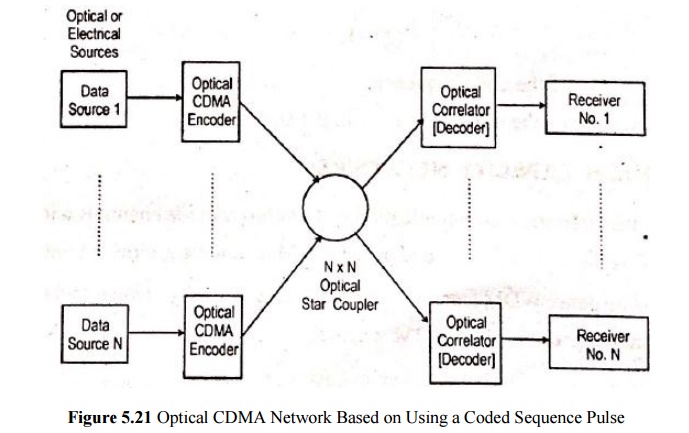Chapter: Optical Communication and Networking : Optical Networks
Optical CDMA
Optical CDMA
The
simplest configuration,CDMA achieves multiple access by assigning a unique code
to each user.
To
communicate with another node, user imprint their agreed upon code onto the data.
The receiver can then decode the bit stream by locking onto the code sequence.
The
principle of optical CDMA is based on spread-spectrum techniques.
The
concept is to spread the energy of the optical signal over a frequency band
that is much wider than the minimum bandwidth required to send the information.
Spreading
is done by a code that is independent of the signal itself.
On
optical encoder is used to map each bit of information into the high-rate
(longer-code-length) optical sequence.
The
symbols is the spreading code are called chips.
The
energy density of the transmitted waveform is distributed more or less
uniformly over the entire spread-spectrum bandwidth.
The
set of optical sequences becomes a set of unique ‘address codes or signature
sequences’ the individual network users.

The
signature sequence contains six chips. When the data signal contains 1 data
bit, the six-chip sequence is transmitted, no chips are sent for a 0 data bit.
Time-domain
optical CDMA allows a number of users to access a network simultaneously,
through the use of a common wavelength.
Both
asynchronous and synchronous optical CDMA techniques. In synchronous accessing
schemes follow rigorous transmission schdules, the produce more successful
transmission (higher throughputs) than asynchronous methods where network
access is random and collisions between users can occurs.
An
optical CDMA network is based on the use of a coded sequence of pulses.
The
setup consists of N transmitter and receiver pairs interconnected in a star

To
send information from node j to node k, the address code for node k is
impressed upon the data by the encoder at node j.
At
the destination, the receiver differentiates between codes by means of
correlation detection.
Each
receiver correlates its own address f(n) with the received signal s(n). The
receiver output r(n) is

If
the received signal arrives at the correct destination, then s(n)=f(n).
Equation (5.57) represents an autocorrelation function, if s(n) not equal to f(n) the equation (5.57) represents a cross-correlation function.
For
a receiver to be able to distinguish the proper address correctly, it is
necessary to maximize the autocorrelation function and minimize the
cross-correlation function.
Prime-sequence
codes and optical orthogonal codes (OOCs) are the commonly used spreading
sequences in optical CDMA systems.
An
OOC systems the number of simultaneous user an is bounded by

Related Topics